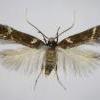35.079 Oxypteryx wilkella (Linnaeus, 1758)
Status and Distribution
The genus Eulamprotes is now considered a junior synonym of Oxypteryx.
Very local with a scattered distribution in England (excluding the south west), Wales, eastern Scotland and south-east Ireland. Associated with dry, sandy areas it is predominantly coastal in the west and more northerly parts of its range. In England, roughly south of a line from the Humber Estuary to the River Mersey, it also occurs at several favoured inland sites in areas such as the Breck region and at former sand and gravel quarries in a few parts of Yorkshire.
See note under Similar Species in the 'Finding' section relating to additional species found in Europe that are similar to this moth.
Microlycus harcalo, a Chalcid wasp, has been bred from this species - Microlycus harcalo (Walker, 1852) (Hymonoptera: Chalcidoidea, Eulophidae) rediscovered, description of the female and a host record R. R. Askew & R. J. Heckford; Entomologist's Monthly Magazine 152: 149-154.

Provisional map
Foodplant and Larval Feeding Signs
Syntrichia ruralis ssp. ruraliformis (sand-hill screw-moss), see plant distribution map, Hypnum lacunosum var. lacunosum (great plait-moss) and Dicranum scoparium (broom fork-moss) - see Sterling, 2008 and Beavan & Heckford, 2015.
Prior to this, reference material suggested Cerastium fontanum (common mouse-ear) was the foodplant, this originating from Stainton, 1867, The Natural History of the Tineina 10, ix, where the larva were said to make webs along the stems and pale blotches on some leaves. This is now considered a very unlikely host for reasons explained in Sterling, 2008 and Beavan and Heckford, 2015 and 2017.
Feeds in silken tubes below the surface with no visible signs of feeding at ground level although on occasions has been found to leave an orange-brown frass pile on the surface of Syntrichia.
Habitat
Finding the Moth
Larva: feeding is considered to commence in March and goes through to May while pupation is amongst the moss from May into June. Found feeding on Hypnum lacunosum var. lacunosum (great plait-moss) and Dicranum scoparium (broom fork-moss) in Norfolk and Suffolk where the larva constructs an upright (or nearly so) slightly translucent silken tube spun to the stems of the mosses not much wider than the larva and where the upper ends of the tubes were always below the surface of the moss (between several mm and one cm). In North Wales and Dorset found on Syntrichia ruralis ssp ruraliformis (sand-hill screw-moss) at the base of a stem extending into the sandy soil/moss mix beneath in a delicate whitish silken tube incorporating a few chewed moss fragments. The anterior end of this tube opens into a bell mouth below the feeding area and orange-brown frass is deposited at the posterior end, this frass sometimes visible on the surface of the moss.
Adult: has been found amongst Thymus sp. (thyme) and comes to light.
Similar Species
The dark fuscous (blackish-brown) forewing colour contrasting with the whitish head and three silvery fasciae make this a distinctive species. Forms have been found in the British Isles with the second and third fascia obsolete (f. tarquiniella), others with only a basal and middle fascia (those in the BMNH are also under tarquiniella), and an unusual form with the middle fascia absent. It is commented in Beavan and Heckford, 2015 that the tip of the third segment of the labial palpus is black in all forms of O. wilkella although the extent can vary.
A 'Review of the Eulamprotes wilkella species-group based on morphology and DNA barcodes, with descriptions of new taxa (Lepidoptera: Glelechiidae)' by Huemer, P., Elsner, G. & Karsholt, O., 2013, has detailed seven new species found in Europe within the O. wilkella group. Although it currently seems unlikely that any of these species occur within the British Isles it would be worthwhile retaining (not just photographing) any specimens of this species where the following criteria apply, either singly or together:
a) the third silver fascia is obviously broken and/or there is an angle between the two elements of this fascia (ie - it doesn't make a straight line).
b) the pre-apical spot is extended and fuses with the tornal section of the broken third fascia.
c) significant elements of the head are dark coloured (ie - not all white or buff).
d) the antennae have rings or much more or less than the apical quarter is white.
e) wingspan is obviously outside the range of 8 to 10mm.
Genitalia examination is essential to persue the possibility of an additional species in Britain.
Single brooded from June to late August. The suggestion in Stainton (reference above) was that the moth is double brooded, but Dr P H Sterling, in his larval investigations, suggests this is unlikely in Britain.
Earliest: 4th June 2010 (VC H12)
Latest: 9th September 2007 (VC25)







%201_0.jpg)
%202_0.jpg)
%203_0.jpg)
%204_0.jpg)





